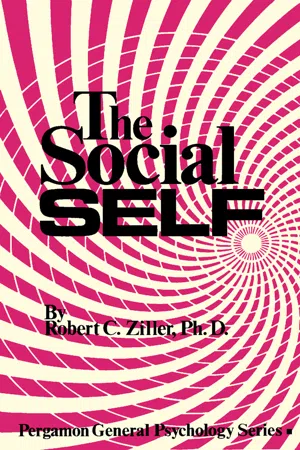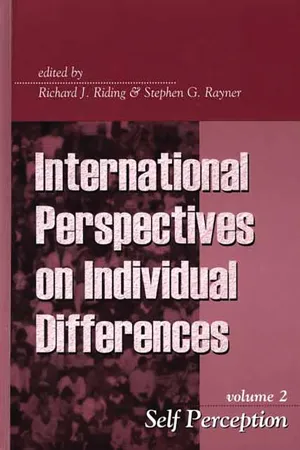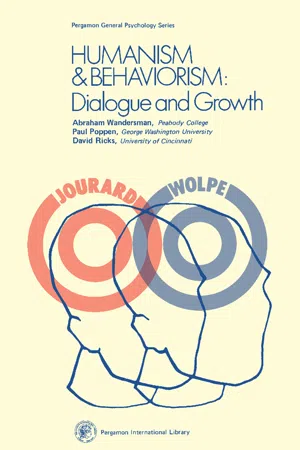Psychology
Concepts of the Self
The "Concepts of the Self" in psychology refer to the various ways individuals perceive and understand themselves. This includes aspects such as self-identity, self-esteem, self-concept, and self-awareness. These concepts are central to understanding human behavior, cognition, and emotions, and they play a significant role in shaping an individual's thoughts, feelings, and actions.
Written by Perlego with AI-assistance
Related key terms
1 of 5
10 Key excerpts on "Concepts of the Self"
- eBook - PDF
- Saba Safdar, Catherine A. Sanderson(Authors)
- 2021(Publication Date)
- Wiley(Publisher)
This is a useful quote to consider, as it draws our attention to some of the assumptions that Western cultures, and therefore the psychology that developed in those cultures, hold about what a person, or self, is. For example, the self has boundaries or edges and is distinct from its environ- ment. Each self is also assumed to be unique. It is like a little universe of thoughts, motivations, awareness, emotions, decision-making, and behaviour. It is also a whole thing, not part of another thing. It is separate from other similar whole selves. Geertz also draws our attention to other ways to understand the self, namely, that outside the Western individualistic countries and the field of social science, the Western notion of self is (to use his phrase) a “rather peculiar idea.” The Western quest to understand the self can be traced back to (at least) 2,500 years ago (around 500 BCE), when the Greek philosopher Socrates wrote, “Know thyself,” which is certainly more easily said than done. Our view of ourselves is often distorted in a variety of ways, and even knowing what “self ” is can be problematic. Since the late 19th century, however, social psychologists have examined the meanings of the nature of self, and the scientific approach has now generated a large amount of information about the self, as you will also see throughout this chapter. WHAT ARE THE SELF-CONCEPT AND SELF-AWARENESS? This section examines the distinction between self-concept and self-awareness. We will also review three functions of self: interpersonal tool, decision maker, and regulatory system. If someone were to ask you what you’re like, what would you say? You might say “smart,”“funny,”“friendly,” or “athletic.” All of these would describe your self-concept, that is, your overall beliefs about your own attributes. According to William James, a pioneering American psychologist, self-concept is one aspect of the self and can be referred to as the Known or the Me ( James, 1890). - eBook - PDF
Social Beings
Core Motives in Social Psychology
- Susan T. Fiske(Author)
- 2018(Publication Date)
- Wiley(Publisher)
The self can serve various social-psychological functions; having a self is not only knowing where your skin ends but also how to get along in a group. Summary of Definitions and Motives The self is not a fixed entity but depends on the situation. A conceptual definition of the self includes the body, the inner self, the interpersonal self, and the collective self. Operationally, social psychologists have examined the self-concept (e.g., the who-am-I statements), self-esteem (e.g., the Rosenberg scale), and self-presentation (e.g., how behavior differs in public and private). Self-understanding, self-enhancing, and self-belonging all facilitate survival within the group. Self-Concepts: Understanding the Self Before going further, do a little experiment. (a) Read the following words, thinking about how much each one, in turn, describes you. (To play fair, you should take about three seconds per word.) Ready? OK, to what extent are you: Friendly. Smart. Silly. Creative. Athletic. Gloomy. Self-Concepts: Understanding the Self 151 Dedicated. (b) Now, without looking back at the words, think of the whole first verse of the “Star Spangled Banner.” Look away from the book until you are finished. (c) Now, without looking back at the personality trait words, write down as many of them as possible. Give yourself enough time. How many did you get? When I teach social psychology, half the class is assigned to do what you did, apply the words to themselves in part (a), and the other half of the class is assigned to consider the words just by counting the vowels in them. The vowel-counters remember only two or three words, if that; they can rapidly identify vowels without reading the words. The self-description people typically get five or more. When they read each word, considering how it relates to themselves, they are accessing a whole storehouse of knowledge about self. - eBook - PDF
Psychology and the Challenges of Life
Adjustment and Growth
- Spencer A. Rathus, Jeffrey S. Nevid(Authors)
- 2019(Publication Date)
- Wiley(Publisher)
4. You perceive your personal self by direct awareness. 5. Our may be defined in terms of the importance we place on objects and things. Think About It Consider your values and your relationships with various family mem- bers and other people you know. To what degree does sharing values relate to your closeness and intimacy with other people? Self-Perception: Self-Concept, Self-Esteem, and Self-Identity 191 Self-Esteem Increases Throughout Much of Adulthood Research shows that people in middle adulthood tend to have higher self-esteem than younger adults. Why do you suppose that is the case? Hongqi Zhang/Alamy Stock Photo Self-Perception: Self- Concept, Self-Esteem, and Self-Identity Other aspects of self-perception include our self-concept, self-esteem, and self-identity. With the self-concept, we again look inward to parts of ourselves that can be per- ceived directly by us alone. We may try to communicate what is within us, but we alone can perceive it. The Self-Concept Your self-concept is your impression or understanding of yourself. It reflects the traits or qualities you attribute to yourself, such as fairness, competence, and sociability— or not. Your self-concept has a major impact on your basic judgment of yourself—your self- esteem. Self-esteem depends on many factors, including social approval, competence, and the discrepancy between the way you see yourself and what you think you ought to be—your self- ideal, or ideal self. (See photo.) The nearby Self-Assessment provides an opportunity for you to evaluate your self-concept on a number of dimensions and to size up how closely your self-concept matches your concept of an ideal self. If your self-concept lags behind your ideal self, don’t throw in the towel. Self-Esteem Our self-esteem may depend on the degree to which our impressions of ourselves fit with our ideal selves (or self-ideals)—the selves we feel we ought to be. - No longer available |Learn more
Psychology Applied to Modern Life
Adjustment in the 21st Century
- Wayne Weiten, Dana Dunn, Elizabeth Hammer(Authors)
- 2014(Publication Date)
- Cengage Learning EMEA(Publisher)
These distinc- tive qualities fit into their self-definitions. As we will see, the self is both a cognitive and a social construct (Bau- meister, 2012), one that emerges in early childhood and unfolds through adolescence (Harter, 2012). How did you develop beliefs about yourself? Have your self-views changed over time? Read on. The Nature of the Self-Concept Although the self-concept is usually talked about as a single entity, it is actually a multifaceted structure (Oyserman, El- more, & Smith, 2012). That is, the self-concept is an orga- nized collection of beliefs about the self. The self-concept entails your beliefs about your personality (Markus & Cross, 1990), those things than come to mind when you think about yourself (Stets & Burke, 2003), and what you believe to be true about yourself (Forgas & Williams, 2002). These beliefs, also called self-schemas, shape social percep- tion (Showers & Zeigler-Hill, 2012), are developed from past experience, and are concerned with your personality A t last you are in college and on your own, away from home. You are a little nervous but excited about your new life and its challenges. Today is your first official day of college and psychology is your first class. You arrive early. You take a seat near the front of the lecture hall and immediately feel conspicuous. You don’t know anyone in the class; in fact, you suddenly realize you don’t know anyone at the university except your roommate, who is still a stranger. Many students seem to know one another. They are laughing, talking, and catching up while you just sit there, quiet and alone. They seem friendly, so why won’t they talk to you? Should you speak to them first? Are you dressed okay—what about your hair? You begin to question yourself: Will you ever make any friends in this class or at the university? Oh, here comes the professor. She seems nice enough, but you wonder what she expects. - eBook - PDF
The Social Self
Pergamon General Psychology Series
- Robert C. Ziller, Arnold P. Goldstein, Leonard Krasner(Authors)
- 2013(Publication Date)
- Pergamon(Publisher)
Development of Self-Other Concepts Part III Throughout, it has been necessary to consider the evolution of the self concept. In describing the concept of social interest, for exam-ple, the continuous conflict between the need for independence and need for dependence was described throughout the life cycle. In the next two chapters, development of the self concept becomes the central concern. In Chapter 6, studies dealing largely with age are discussed. The inexorable process of aging combined with the need for stability presents a continuous conflict for the individual. It is proposed here that the resolution of this conflict is reflected, in part, in the self concept. Chapter 7 is concerned with environmental factors associated with the development of the self concept. These include geographic mobility, culture, family setting, and physical disability. Social reinforcement of individual behavior will vary according to the social setting and will be reflected in the person's social interest and self-esteem. Together, these two sections describe the cognitive and the be-havioral approaches to the study of the concept of the self. The cog-nitive approach tends to emphasize the primacy of the self concept as it is related to behavior. The latter approach emphasizes the influence of behavior on the self concept. The confluence of these two approaches is one of the most exquisite theoretical problems in psychology. C H A P T E R 6 Consistency and Change of the Social Self A persistent dilemma for the student of social behavior as well as the person being studied is that of maintaining some semblance of stability under conditions of continual change (Lecky, 1945). A degree of stability or consistency with regard to perceptions of the self and others is required in order to reduce the complexity of the environment to manageable pro-portions. To borrow from another adage, it might be proposed that even if consistency did not exist, it would be invented. - eBook - PDF
- Richard Riding, Stephen Rayner, Richard Riding, Stephen Rayner(Authors)
- 2001(Publication Date)
- Praeger(Publisher)
It was described as a configuration that could be dramatically altered by one aspect affecting the whole and reflecting how the person saw the self. It was described as a continuous process that reflected the self as known and Aspects of the Self as Learner 29 the self as knower. Behavior, ultimately, was viewed as “the goal-directed attempt of the organism to satisfy its needs as experienced in the field as perceived” (Ro- gers, 1951, p. 491). Rogers also distinguished between the self-concept and “ideal self.” He did not interpret any difference between the two as a potential source of disturbance but saw such disturbance rather as the result of perceptions of the environment and the need for consistency between these perceptions and the self-concept (realism). Person-centered therapy was aimed at building congruency between the environ- ment and the self in an effort to close the gap between self-concept, the environ- ment, and the ideal self. Experimental Psychology Psychologists interested in self-concept carried out a great deal of independent experimental research during the 1950s, 1960s, and 1970s, characterized by one- time experiments, which were often predicated on a “global” or “unitary” model of self-concept. Examples can be found in the work of Piers and Harris (1969), Burns (1979), or Lawrence (1996). This approach, however, failed to reveal any positive evidence to support the construct. Instead, researchers progressively moved towards a realization that the phenomenon they were seeking to validate was a multidimensional and dynamic system in which several context- or domain- related self-concepts might be distinguished. Shavelson, Hubner, and Stanton (1976) were the first researchers to propose that self-concept should be understood as a complex set of self-perceptions. - Herbert Marsh, Rhonda G. Craven, Dennis M. McInerney(Authors)
- 2017(Publication Date)
- Information Age Publishing(Publisher)
Further, the benefits of feeling positively about oneself in relation to choice, planning, persistence, and subsequent accomplishments transcend traditional disciplinary and cul-tural barriers. Here, in addition to reviewing the theoretical and methodological issues most central to self-concept research, we will reflect upon implications for research, policy, and practice. Key areas of the literature that will be cov-ered relate to the following: the multidimensionality of self-concept (e.g., Do self-concept models • hold up cross-nationally and cross-culturally? Can children as young as 5 or 6 distinguish between multiple dimensions of self-concept?) the causal ordering of self-concept and other variables (e.g., What • comes first: academic self-concept or academic performance? Does physical self-concept impact upon sports performance?) frame of reference effects, both internal and external (e.g., Why do • people think of themselves as “math” persons or “verbal” persons? Why do self-concepts decline for gifted students who attend selective schools, and for learning disabled students in regular classrooms?) the self-concept profiles of certain groups (e.g., How different are • the self-concepts of bullies and victims? How do self-concepts of elite swimmers contribute to winning gold medals?) enhancing self-concept (e.g., What is the importance of using multi-• dimensional measures of self-concept in intervention evaluation?) THE UBIQUITOUS CONSTRUCT AND THE MULTIDIMENSIONAL DILEMMA Self-concept is widely acknowledged as a critical construct.- eBook - PDF
Humanism and Behaviorism
Dialogue and Growth
- Abraham Wandersman, Paul J. Poppen, David F. Ricks(Authors)
- 2016(Publication Date)
- Pergamon(Publisher)
Many psychologists (including Gordon Allport who, in 1937 and 1961, wrote so persuasively on this topic) are unwilling to give the self such extra-ordinary causal powers: To say that the self does this or that, wants this or that, wills this or that, is to beg a series of difficult questions. The psychologist does not like to pass the buck to a self-agent ... It is unwise to assign our problems to an inner agent who pulls the strings (Allport, 1961, pp. 129-130). THE SELF IS THE PERSON To resolve ambivalence about the concept of self, one wants to avoid the pitfalls of pseudoexplanations (into which the concept of a self as causal agent quickly leads) without throwing out the subjective reality of self-experience (self-awareness) and without neglecting the person who does the experi-encing. A first step might be to fully equate such terms as the self, the I, and the ego, and to treat each as a synonym for the total individual. This equivalence should be least reduce the chance of being beguiled by explana-tions in which the self is used to account for the individual's behavior, or in which a person's problems are seen as due to his weak ego. Behavior is generated by the person, not by a self, ego, or other agent distinct from the individual. The suggestion to equate self and person is hardly unique. Indeed, it seems to be shared by such diverse theorists as Skinner (1974) and Royce (1973). As the latter put it: The 'self here is not a mental construct, but a living organism, a person. When I say that I cut myself shaving this morning, I do not mean that I cut a mental construct. Likewise, if you hit me, that ' I ' who got hit is not some 'ego' of Freudian theory. We are talking here not about one's self-concept or self-image but about the existing reality. And this reality is the same referent when we say, ' I understand,' or ' I choose ' or ' I run ' .... The person or self, then, is the behaving organism. [Royce, 1973, p. 885.] - eBook - PDF
- Gerald E. Myers(Author)
- 1985(Publication Date)
- Yale University Press(Publisher)
SELF SELF-ACQUAINTANCE If a topic interested James, he discussed it in essay upon essay; many of the chapters in Principles, for instance, are elaborations of earlier articles or are elabo-rated in later ones. But the concept of self, while a profound concern of his, is treated almost exclusively in The Consciousness of Self. 1 The concept is implicit in his discussions of mind and body, consciousness, psychical research, and abnormal psychology, but we expect further studies of issues about the self. He may have judged that his ideas about the self beyond the context of the psychology of self-consciousness or of the mind-body relation were sufficiently personal to be confined to soliloquies and personal correspondence. 2 More important, he seems to have concluded that a philosophical account of the self gives way to a mystical one and that useful words on the subject are rapidly exhausted. In any event, he wrote prolifically about matters directly relevant to the concept of self, and we thus have adequate sources for reconstructing his own view of it. While in Dresden in 1868, at the age of twenty-six, James read an article on children's mental development and commented on it in his diary. Use of I by child comes not fin. absence of concept but from his imitating literally what he hears others say. [The author's] child e.g. used to speak of himself with du as well as with Arnold and spoke of & to his Father with I. Quotes from Lazarus das Kind wendet auch 'er' u. 'wir' nicht viel fruher an als 'ich'. - eBook - PDF
- Catherine A. Sanderson, Saba Safdar(Authors)
- 2014(Publication Date)
- Wiley(Publisher)
This means that the self is more connected to its social context and acts primarily as a response to others within the social context. An interdependent self-construal conceives the self as connected to others, with behaviour contingent on the values, thoughts, and preferences of others. Accordingly, the self is more meaningful in a relationship and is connected to the whole. The construal of the self as interdependent is more common in South American, Asian, and African societies. A conceptual presentation of self, as suggested by Markus and Kitayama (1991), is illus- trated in Figure 3.5. The large circle is self and the smaller circles are others in relationships. The distances between the large and the small circles indicate the closeness of the self and others. The number of Xs in circles indicates various aspects of the self that are shared with others. As shown in Figure 3.5a, in independent self-construal there is a solid line separating the self from others (i.e., the self as autonomous), but in interdependent self-construal the large circle is separated from small circles by a dashed line (Figure 3.5b). This indicates that the interdependent self-construal is defined in relationships with specific others and that these relationships with others guide an individual’s behaviour. independent self-construal – a conception of the self as autonomous and independent from others, and behaving primarily to express its own internal attributes interdependent self-construal – a conception of the self as connected to others, with its behaviour contingent on the values, thoughts, and prefer- ences of others 95 How Does Culture Influence Self? FACTORS INFLUENCING THE SELF-CONCEPT As described in Chapter 1, people in different cultures see themselves in very different ways.
Index pages curate the most relevant extracts from our library of academic textbooks. They’ve been created using an in-house natural language model (NLM), each adding context and meaning to key research topics.









